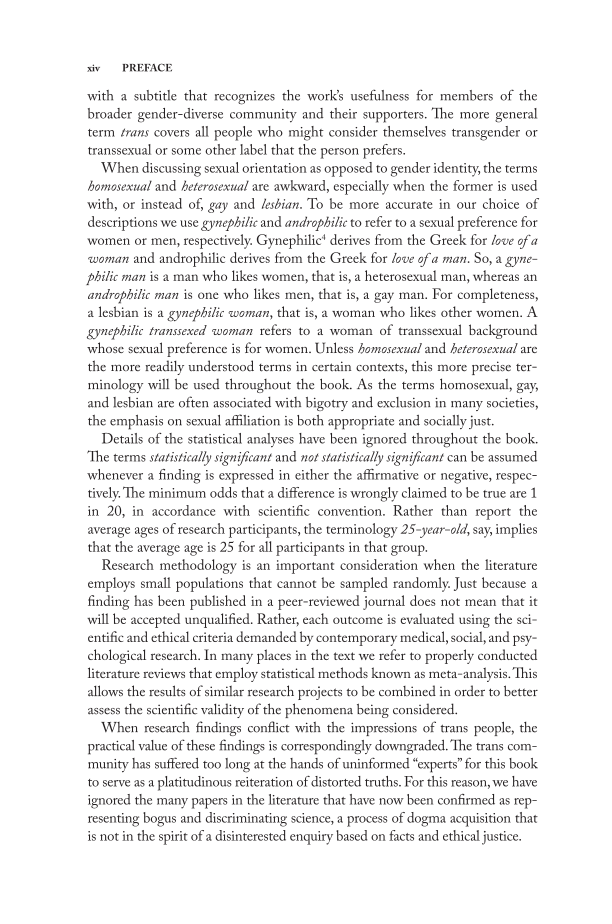xiv PREFACE with a subtitle that recognizes the work’s usefulness for members of the broader gender-diverse community and their supporters. The more general term trans covers all people who might consider themselves transgender or transsexual or some other label that the person prefers. When discussing sexual orientation as opposed to gender identity, the terms homosexual and heterosexual are awkward, especially when the former is used with, or instead of, gay and lesbian. To be more accurate in our choice of descriptions we use gynephilic and androphilic to refer to a sexual preference for women or men, respectively. Gynephilic4 derives from the Greek for love of a woman and androphilic derives from the Greek for love of a man. So, a gyne- philic man is a man who likes women, that is, a heterosexual man, whereas an androphilic man is one who likes men, that is, a gay man. For completeness, a lesbian is a gynephilic woman, that is, a woman who likes other women. A gynephilic transsexed woman refers to a woman of transsexual background whose sexual preference is for women. Unless homosexual and heterosexual are the more readily understood terms in certain contexts, this more precise ter- minology will be used throughout the book. As the terms homosexual, gay, and lesbian are often associated with bigotry and exclusion in many societies, the emphasis on sexual affiliation is both appropriate and socially just. Details of the statistical analyses have been ignored throughout the book. The terms statistically significant and not statistically significant can be assumed whenever a finding is expressed in either the affirmative or negative, respec- tively. The minimum odds that a difference is wrongly claimed to be true are 1 in 20, in accordance with scientific convention. Rather than report the average ages of research participants, the terminology 25-year-old, say, implies that the average age is 25 for all participants in that group. Research methodology is an important consideration when the literature employs small populations that cannot be sampled randomly. Just because a finding has been published in a peer-reviewed journal does not mean that it will be accepted unqualified. Rather, each outcome is evaluated using the sci- entific and ethical criteria demanded by contemporary medical, social, and psy- chological research. In many places in the text we refer to properly conducted literature reviews that employ statistical methods known as meta-analysis. This allows the results of similar research projects to be combined in order to better assess the scientific validity of the phenomena being considered. When research findings conflict with the impressions of trans people, the practical value of these findings is correspondingly downgraded. The trans com- munity has suffered too long at the hands of uninformed “experts” for this book to serve as a platitudinous reiteration of distorted truths. For this reason, we have ignored the many papers in the literature that have now been confirmed as rep- resenting bogus and discriminating science, a process of dogma acquisition that is not in the spirit of a disinterested enquiry based on facts and ethical justice.
Document Details My Account Print multiple pages
Print
You have printed 0 times in the last 24 hours.
Your print count will reset on at .
You may print 0 more time(s) before then.
You may print a maximum of 0 pages at a time.
































































































































































































































































































